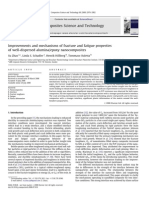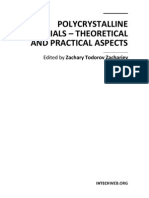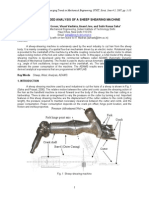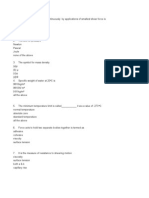Assignment:: Module - 1: Fundamental Concepts Relevant To Metal Forming Technology Forming of Materials
Uploaded by
Harsh SharmaAssignment:: Module - 1: Fundamental Concepts Relevant To Metal Forming Technology Forming of Materials
Uploaded by
Harsh SharmaModule -1: Fundamental concepts relevant to metal forming technology
Forming of materials
1. Distinguish between crystalline and amorphous materials.
Assignment:
2. How does elastic deformation and plastic deformation affect the lattice structure of crystals?
3. Give examples for materials that do not have crystalline structure.
4. Which one of the following crystal structure has fewer slip systems, so that the material
having that structure is more difficult to deform at room temperature?
5. How many effective number of atoms are there in unit cell of HCP?
6. Calculate the packing factor for FCC unit cell.
7. State Hookes law.
8. Define work hardening.
9. Define instability in tension.
10. What test is commonly used for determining the strength properties of brittle materials?
11. What method of hardness measurement is suitable for very thin sections like foils?
12. Why higher value of m - the strain rate sensitivity parameter results in more diffuse neck in
tensile loading?
13. A certain material has a Poissons ratio of 0.5. What is its dilation?
14. What is the significance of slip systems?
15. A certain wire has a diameter of 1 mm. This wire has been made from a rod of 10 mm
diameter. Calculate the longitudinal and diametral engineering and true strains undergone by
the wire during its production.
16. A material has plastic stress strain behavior represented = K(+ n)
n
17. A torque of 700 N-m is applied on a torsion test specimen of radius equal to 20 mm, wall
thickness of 2 mm. The specimen has a gage length of 50 mm. The specimen undergoes an
. K is strength
coefficient. Determine the true strain at which necking of the material begins during uniaxial
tensile loading. Is it possible to have such a material?
NPTEL - Mechanical Engineering - Forming
Joint Initiative of IITs and IISc Funded by MHRD Page 1 of 2
angular deflection of 0.2
o
. Calculate the shear stress, shear strain and shear modulus if the
deformation is elastic.
NPTEL - Mechanical Engineering - Forming
Joint Initiative of IITs and IISc Funded by MHRD Page 2 of 2
You might also like
- Excersises For Essentials and Engineering of MaterialsNo ratings yetExcersises For Essentials and Engineering of Materials5 pages
- Failure and Fracture of Short Flass Fibre Reinforced Nylon Composites MooreNo ratings yetFailure and Fracture of Short Flass Fibre Reinforced Nylon Composites Moore8 pages
- Engineering Materials and Metallurgy 2 Marks PDFNo ratings yetEngineering Materials and Metallurgy 2 Marks PDF21 pages
- Assignment - Module - 1 - Properties of MatterNo ratings yetAssignment - Module - 1 - Properties of Matter1 page
- Physics Mechanical Properties of Solids (Practice Problems) : Important Formulae100% (2)Physics Mechanical Properties of Solids (Practice Problems) : Important Formulae2 pages
- Valliammai Engineering College: Question Bank-I Semester - PH6151-Engineering Physics - INo ratings yetValliammai Engineering College: Question Bank-I Semester - PH6151-Engineering Physics - I10 pages
- Fracture Toughness Determinations by Means of Indentation FractureNo ratings yetFracture Toughness Determinations by Means of Indentation Fracture19 pages
- MAM College of Engineering: Two Mark Questions and AnswersNo ratings yetMAM College of Engineering: Two Mark Questions and Answers31 pages
- On The Da Vinci Size Effect in Tensile Strengths of Nanowires - A Molecular Dynamics StudyNo ratings yetOn The Da Vinci Size Effect in Tensile Strengths of Nanowires - A Molecular Dynamics Study8 pages
- Engineering Materials and Metallurgy 2 Mark With AnswersNo ratings yetEngineering Materials and Metallurgy 2 Mark With Answers31 pages
- Sheet (1) : Introduction: Main Learning ObjectivesNo ratings yetSheet (1) : Introduction: Main Learning Objectives3 pages
- Tutorial 4_Part II - Strength of MaterialsNo ratings yetTutorial 4_Part II - Strength of Materials3 pages
- Composites Science and Technology: Su Zhao, Linda S. Schadler, Henrik Hillborg, Tommaso AulettaNo ratings yetComposites Science and Technology: Su Zhao, Linda S. Schadler, Henrik Hillborg, Tommaso Auletta7 pages
- Direct Comparison of Stylus and Resonant Methods For Determining Young's Modulus of Single and Multi Layer MEMS CantileversNo ratings yetDirect Comparison of Stylus and Resonant Methods For Determining Young's Modulus of Single and Multi Layer MEMS Cantilevers21 pages
- Damage of Woven Composite Under Translaminar Cracking Tests Using Infrared ThermographyNo ratings yetDamage of Woven Composite Under Translaminar Cracking Tests Using Infrared Thermography22 pages
- Mechanical Properties Solids Questions Class11No ratings yetMechanical Properties Solids Questions Class112 pages
- Mechanical Behaviour Laboratory MSE 313: Laboratory ManualNo ratings yetMechanical Behaviour Laboratory MSE 313: Laboratory Manual41 pages
- MSE 209: Introduction To The Science and Engineering of MaterialsNo ratings yetMSE 209: Introduction To The Science and Engineering of Materials6 pages
- Elements of Materials Science and Engineering: Instructor: Dr. Ahmed Arafat, PHDNo ratings yetElements of Materials Science and Engineering: Instructor: Dr. Ahmed Arafat, PHD36 pages
- Mechanical Properties and Fracture Toughness of Organo-Silicate Glass (OSG) Low-K Dielectric Thin Films For Microelectronic ApplicationsNo ratings yetMechanical Properties and Fracture Toughness of Organo-Silicate Glass (OSG) Low-K Dielectric Thin Films For Microelectronic Applications13 pages
- 600+ TOP MECHANICAL ENGINEERING Interview Questions & Answers100% (1)600+ TOP MECHANICAL ENGINEERING Interview Questions & Answers37 pages
- Composite Substructures With Partial Shear Connection: Low Cycle Fatigue Behaviour and Analysis IssuesNo ratings yetComposite Substructures With Partial Shear Connection: Low Cycle Fatigue Behaviour and Analysis Issues8 pages
- Polycrystalline Materials - Theoretical and Practical AspectsNo ratings yetPolycrystalline Materials - Theoretical and Practical Aspects176 pages
- Electric Convection Built-In Oven: Installation ManualNo ratings yetElectric Convection Built-In Oven: Installation Manual13 pages
- Production - Consumption Model: Households Consumptio NNo ratings yetProduction - Consumption Model: Households Consumptio N1 page
- Computer Aided Analysis of A Sheep Shearing MachineNo ratings yetComputer Aided Analysis of A Sheep Shearing Machine10 pages
- Fluid Mechanics Objective Type QuestionsNo ratings yetFluid Mechanics Objective Type Questions223 pages





































































